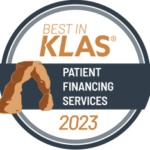Customer Care: 866.625.8532 Sales Inquiries: 503.419.3544

KLAS Research Awards CarePayment Top Patient Financing Company for 2023 - Read Press Release
Blog | November 16, 2023
Why Your 2024 Planning Needs Modern Patient Financial Engagement

The U.S. healthcare landscape is currently grappling with a harsh reality: nearly half of American adults lack the funds to cover an unexpected $500 medical bill. The Kaiser Family Foundation’s poll in 2022 uncovered alarming statistics, revealing that 41% of surveyed individuals, totaling more than 100 million adults, currently carry medical or dental debt. Moreover, a quarter of these individuals owe over $5,000, and half of that group are burdened with debts exceeding $10,000.
Addressing the Patient Financial Crisis
This crisis disproportionately affects younger adults, leading to denial of care for about 1 in 7 people, exacerbating racial disparities, and amplifying hardships for individuals battling chronic illnesses. The fallout from medical debt reaches far beyond financial strain, obstructing opportunities for saving, investing in education, and even cutting back on food, clothing, and other basics.
In 2023, a study showed that 34 percent of patients skipped out on healthcare this year because of medical debt, up from 28 percent of patients who did the same in 2022. As inflation takes a toll on the larger economy, providers can expect that patients will continue to have a hard time paying their medical bills, with 67 percent of surveyed patients saying that inflation has made paying their medical debt more difficult this year.
What Does This Mean for Providers?
The startling statistics on medical debt align with hospital’s own financial woes in recent years—approximately half of U.S. hospitals finished 2022 with a negative margin. To make a profit, providers need patients to not only pay their bills, but to feel financially empowered.
In 2024, providers can aid patients in feeling confident that they can receive and pay for their care by working towards implementing goals like flexible payment options. 91% of patients said it was easier to pay for medical expenses when they have at least 12 months to pay. When patients have access to flexible, 0% APR, long-term payment options, the burden of medical expenses becomes less overwhelming. Implementing this approach provides patients with a chance to manage their healthcare costs without the immediate strain of high-interest rates, allowing for a more manageable financial journey. It empowers patients to seek necessary medical care without the worry of being crippled by mounting debts, while providers get paid for their work.
Additionally, offering solutions like financial counseling, transparent pricing, and cost estimates before care can aid patients in feeling confident and empowered to have the best financial experience. According to a TransUnion Healthcare survey, nearly 65% of patients said they would be more willing to make at least a partial payment if they got an estimate at the time of their healthcare service.
With rising cost of living, healthcare, and other financial pressures impacting consumers, offering patients alternative payment options and other solutions to make paying for care easier is not just a compassionate choice – it’s strategically necessary for a successful financial experience for you and your patients. All these facts and figures indicate an urgent need for healthcare providers to adapt their approaches to patient care in the coming year and beyond. Adapting to these shifting patient expectations is key in preparing for a successful and patient-centric 2024.


